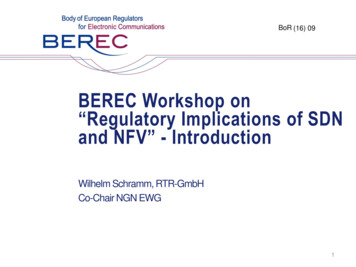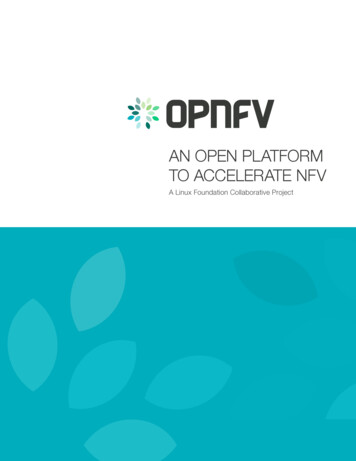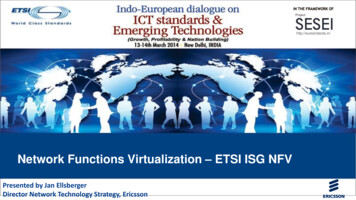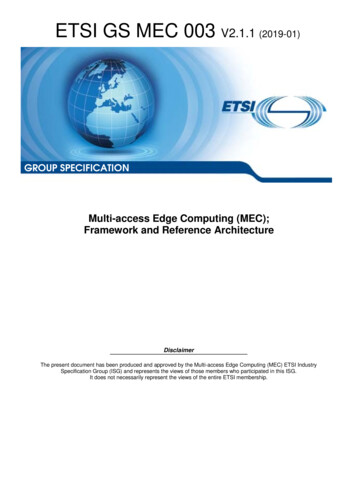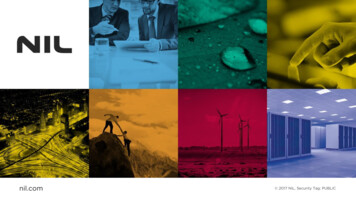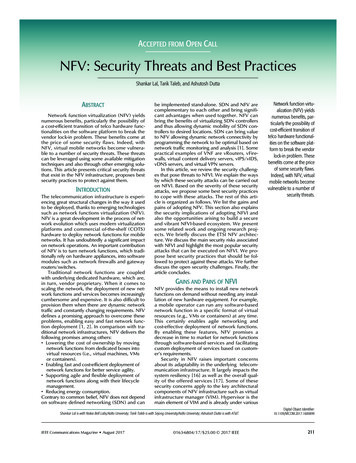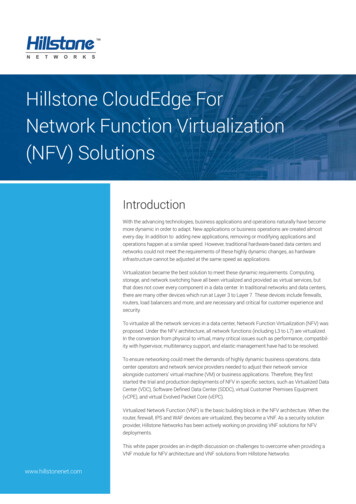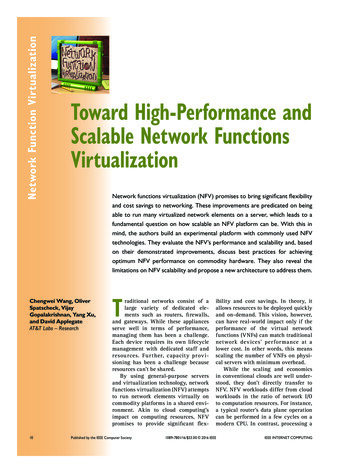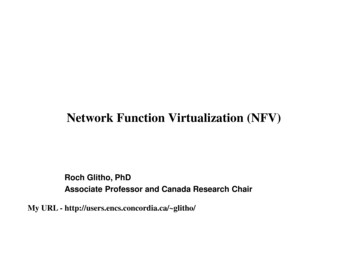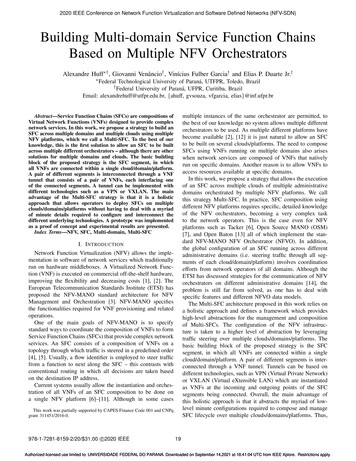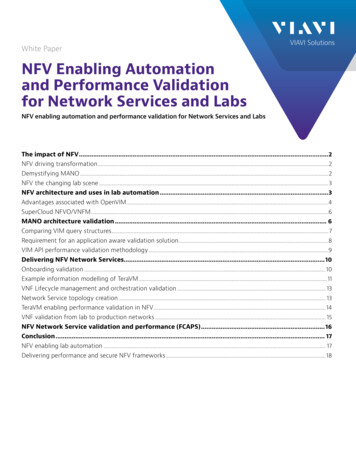
Transcription
White PaperVIAVI SolutionsNFV Enabling Automationand Performance Validationfor Network Services and LabsNFV enabling automation and performance validation for Network Services and LabsThe impact of NFV.2NFV driving transformation.2Demystifying MANO.2NFV the changing lab scene.3NFV architecture and uses in lab automation.3Advantages associated with OpenVIM.4SuperCloud NFVO/VNFM.6MANO architecture validation. 6Comparing VIM query structures. 7Requirement for an application aware validation solution.8VIM API performance validation methodology.9Delivering NFV Network Services.10Onboarding validation.10Example information modelling of TeraVM.11VNF Lifecycle management and orchestration validation. 13Network Service topology creation. 13TeraVM enabling performance validation in NFV. 14VNF validation from lab to production networks. 15NFV Network Service validation and performance (FCAPS). 16Conclusion. 17NFV enabling lab automation. 17Delivering performance and secure NFV frameworks.18
The Impact of NFVNetwork function virtualization (NFV) is revolutionizing both how carriers enable network services and hownetwork solution vendors approach and deliver network products. With carriers seeking to deliver new networkservices to their customers in weeks rather than months, carriers are aggressively pushing solution vendors todeliver more in shorter time frames.To meet these aggressive time-lines lab automation is now a critical component to success for NFV. The goal of thisapplication note is to enable both carriers and solution vendors to make an informed decision on what automationmeans in terms of delivery of a NFV enabled network service. But it also shows how automation for NFV differsfrom the traditional tools that may exist in labs today.The ETSI ISG NFV ogies/nfv), is one of the driving forces behindrecommending how carriers and solution vendors approach the future of networking. A key take-away from theirpublished documentation is that the old ways of delivering product and the automation processes used need tochange. This disruptive transformation means that for the test and measurement industry that a new paradigm ofdelivering test solutions is now upon us.NFV driving transformationProgressive carriers are at an inflection point, in which they no longer see or accept the need for proprietaryhardware and/or vendor solution lock-in. The challenge for many, is how now to adopt and be commerciallysuccessful in this new technology shift, one in which agility and flexibility are core.It’s clear that no two carriers are the same and will take a different approach to NFV, for example this will includethe core technology choices for the management and orchestration (MANO) stack. For network solution vendorsand test solution vendors, the challenge is to be able to provide solutions which are open and agile, which areagnostic to their surroundings i.e. can easily fit into these new platforms. This will include the NFV automationprocess wheel of: onboarding, cataloging, orchestration, deployment and service chaining.Demystifying MANOThe ETSI ISG NFV has delivered multiple recommendations covering the key topics of: architecture design,management flows, orchestration principles, performance management, test and security best practices. Ofparticular interest for lab automation is the management and orchestration (MANO) recommendations.The vision from the carriers is that the next generation of networks will be open, in that the chosen componentscan easily be swapped out. This principle is a driving force behind a number of open-source communities e.g.OpenStack, OpenMANO, OpenNFV, etc.The NFV recommendation for the MANO provides for a modular structure of three key layers, each moduleproviding a level of abstraction enabling simplification of use for the carrier network operations, essentiallyremoving the need for highly skilled personnel to deliver a custom network service. The modules outlined in therecommendations address:yy NFV Orchestration (NFVO) – Onboarding and catalogue management of virtual network functions (VNF)yy VNF Management (VNFM) – Management of the lifecycle of the VNF i.e. update/upgrade/etcyy Virtual Infrastructure Management (VIM) – Resource manager for compute, storage and network2 NFV Enabling Automation and Performance Validation for Network Services and Labs
To enable the abstraction between modules requires an open application programming interface (API) between themodules. With many communities and vendors now electing to use Representational State Transfer (REST), which issimply a client – server communication using the HTTP protocol to communicate instruction sets.MANO and the proposed capabilities are a critical piece of the carriers NFV vision. This means that for networksolution vendors to prove that their solutions are indeed NFV ready, they must deliver or push the VNF through thesame information or objective modeling process and automation process flow that the carrier have deployed. Theadvantage of doing so provides automation to validate packaging, onboarding capabilities, catalogue presentationof metadata, accuracy of deployment scenarios and of course performance in the custom network service.NFV the changing lab sceneFor many to prove NFV readiness and to automate labs for a NFV process flow; is challenging and potentiallycost prohibitive. The fact is - it does not have to be and in this paper we look at using open-source componentsto deliver parts of the MANO architecture. For example a simple and easy to use virtual infrastructure resourcemanager is available in the OpenMANO open-source project supported by the global carrier Telefonica. [https://github.com/nfvlabs/openmano].The OpenVIM component of OpenMANO provides a number of advantages which are highlighted later, butfundamentally is a good foundation for understanding on how products behave in NFV platforms. A furtherobservation is that the software being promoted in the NFV community provides a similar functionality as thatof proprietary lab automation solutions, especially in terms of cataloging, management of deployments andresource management.NFV Architecture and Uses in Lab AutomationAs a starting point for this application note, it’s worth defining a sample platform architecture. The networkfunction virtual infrastructure (NFVI) i.e. where the network service will run, utilizes standard hardware bladeservers (fundamental to the NFV vision) and also uses commodity network interface cards, hence minimizing thecosts of building out scaled labs.An open and standard operating system such as RedHat Ubuntu is used to deliver the core operating system, onwhich the hypervisor is installed. In this instance the Kernel based Virtual Machine (KVM) with Quick Emulator(QEMU) provides the virtualization layer. The popular virtual machine management library (Libvirt) provides astandard interface to assist in managing the virtual machine (VM) instances.For networking, the open libraries for open vswitch are installed along with the OpenFlow controller enablingcentralized management for networking. This approach enables ease of configuring and managing the associatednetwork service (NS) VNF networking topologies, which can be defined as an information model such as a VNFforwarding graph (VNF-FG).As part of the initial investigations into creating the application note, a decision was taken to prove the flexibilityof the MANO stack architecture approach and its APIs. In doing so the logical separation was to implementa proprietary solution to act as the NFVO/VNFM and to use the OpenVIM from the OpenMANO project. Thecombined VNFM and NFVO is provided by Luxoft which is known as SuperCloud.3 NFV Enabling Automation and Performance Validation for Network Services and Labs
The decision to use a proprietary solution for the upper layers of MANO provide a number of advantages:yy API stability – fixed API implementations e.g. orchestrator and VIM (Or-Vi)yy Integration capabilities – enabling performance validation results from TeraVM to be exposed alongside keyperformance indicators for host, VNF and NS SLA.yy Catalogue Management – begin standardizing on the descriptor files necessaryyy VIM agnostic: ability to swap between VIMs e.g. OpenStack/OpenVIM without losing functionalityyy Fault, Configuration, Accounting, Performance, Security (FCAPS): A single pane of glass view for the NFV platform.User Instructions(HTML UI)REST APITeraVMVNFSUTVNFNetworkServicesNFVO & VNFMLibvirtAgentOFL 3DN-Ctrl& vSwitchHypervisor (KVM-QEMU)Ubuntu 14.04REST APIOpenVIMVIMMANOHardware/EmulationNFVIFigure 1: Abstracted NFV platform architectureThe architecture above demonstrates and proves the ability to mix both open-source and proprietary solutionsin the MANO stack. The architecture design enables users to support multiple configuration options of VIM, forexample OpenVIM or OpenStack whilst maintaining the integrity and functionality of the NFV flow process.Advantages associated with OpenVIMOpenVIM has been designed to enable ease of use, it links to open vswitch and Openflow controllers to delivernetworking and management. The networking functionality is similar to that of the OpenStack Neutron module.But that’s where the similarity ends.OpenStack Neutron can be complex to configure and operate.An advantage of OpenVIM is the ability to quickly tune the VNF deployment for performance, tuning techniquessuch as non-uniform memory access (NUMA) can be defined as part of an information model scheme. In OpenStackthis cannot be easily achieved, requiring multiple adoptions on the host and tenant setup e.g. (configure cpuallocation ratios, modify scheduler configurations, etc).Frustratingly for carriers, they are inundated with vendors proposing solutions that support NFV, when all theymerely offer is a software package and instruction set on how to run the software on a VM with prescribedadditional package installs with defined needs. The whole purpose of NFV is to deliver to the carriers packagedsolutions which can use information or objective models in order to create a NS.4 NFV Enabling Automation and Performance Validation for Network Services and Labs
The VNF package consists of the network functions machine images (in KVM known as QEMU Copy On Write orqcow) and descriptor files for deployment. The descriptor files are further segment into a generic VNF descriptor(VNFD) and VNF deployment unit descriptor (VDU). OpenVIM supports ingest of this metadata in its north-boundAPI. For solution vendors, this enables a viable mechanism for their development teams to learn about the VNFonboarding process, to create their first VNFD and VDU and validate the accuracy of the VNF deployment.Another feature of the OpenVIM which is very relevant when it comes to delivering performance in the lab isthe ability to deploy components to use pass through techniques (Direct-Path, SR-IOV, etc) ensuring the solutionvendor can achieve maximum throughput in the physical networking.The OpenMANO project is about simplicity and ease of deployment but by focusing on the key performancetuning attributes enables solution vendors to quickly assess multiple deployment options i.e. orchestrate VNF with/without NUMA.Furthermore, for the development and operations team - OpenVIM’s RESTFul API makes it ideal to run deploymentexercises without the need of any sophisticated user interfaces.An example onboarding exercise could be to use a browser e.g. Firefox with RESTClient (http://restclient.net/)plugin, in which users can quickly start interaction with the infrastructure manager, a full list of API calls is availableon the OpenMANO repository. Ideal for debug scenarios.As we touch on REST API, from a carrier perspective and as part of the recommendations in the ETSI ISG testdocumentation, there is the need to validate performance on these APIs. In the next chapter, we will discuss testmethodology for validation and understanding the performance of the MANO stack and the associated REST API,looking at the associate latency of implementing a command.Figure 2: RESTClient a Mozilla Firefox plugin5 NFV Enabling Automation and Performance Validation for Network Services and Labs
SuperCloud NFVO/VNFMSuperCloud provides an integrated solution for NFVO/VNFM layer, as the abstraction layer above the OpenVIM itprovides an easy to use framework which enables deployment of network services.In addition to enabling the core MANO aspects, a key advantage of the solution is to provide a single plane of glassview on the performance of the running NFV platform and on each of the unique network services running, withkey performance indicators covering compute, networking, and tenant SLAs. SuperCloud delivers a number of keycapabilities, which include:yy Administration functions (complete view of infrastructure and tenants)yy Tenant Management (incl. security, bandwidth allocation)yy Abstraction of network complexity (network topology and network creation)yy VNF Catalogue Management (complete view of available VNF packages)yy VNF onboarding/deployment (ingest VDU & VNF descriptors along with VM images)yy VNF Manager (lifecycle upgrade/update management)yy Performance monitoring (performance metrics covering – host, VNF and NS SLA)Figure 3: SuperCloud UI – Topology implementation screenMANO architecture validationAs discussed in the previous chapter, the use of an API based on Rest requires careful consideration. As each layerof the MANO stack has its own instruction set, meaning there is a translation layer between each which clearlyconsumes compute cycles.For example – “What are the differences in performance between OpenStack and OpenVIM when it comes to NUMAassignment? Both have their own unique instruction sets in order to achieve the correct positioning of the VM.6 NFV Enabling Automation and Performance Validation for Network Services and Labs
As an observation, from a carrier perspective there is a need for a dynamic API which will sit on top of bothVIM types, that can translate the same instruction e.g. schedule NUMA pinning. Clearly both have VIMs has aninstruction set to follow in order to achieve this.A first step in the validation methodology to determine performance of the API, will include:yy Instruction timing performanceyy Ability to handle hundreds of concurrent instructionsyy Responsiveness under duressHowever key to delivering performance validation is the need for a feedback loop. One which is intelligible enoughto translate the business logic being returned, as part of the HTTP responses - so as to deliver the next set ofcommands to send.Again in terms of API selection, simply saying that it is RESTful is one thing, consideration must be given to theformat of the information being communicated. Both OpenStack and OpenVIM have elected to use JavaScriptObject Notation (JSON), enabling ease of presentation of parameters and values.This means the test solution must be layer 7 aware, can parse data and send the next request. This is a statefulawareness is available in TeraVM.Comparing VIM query structuresFor carriers to validate performance of the MANO stack requires that the test and measurement solution must beable to handle numerous query types. Highlighted in the following example are the HTTP request constructs forOpenStack and OpenVIMOpenStack uses security toked-ids, the token-id is created as part of an earlier HTTP GET request. This token-id isspecific to a tenant username/password login post. The token is used to validate user requests, but also helps theVIM to deliver data specific to that tenant.OpenVIM at the time of writing has no security token-id implementation, however the query structure uses atenant-id, which is extracted from a separate HTTP GET request.OpenStackHTTP Header:X-Auth-Token {security.token.id}Content-type: application/JSONCommand: GETLink: http:// IP address OpenStack Image API /v2.0/imagesOpenVIMHTTP Header:X-Auth-Token {not implemented at time of writing}Content-type: application/JSONCommand: GETLink: http:// IP address OpenVIM /openvim/ tenant ID /images7 NFV Enabling Automation and Performance Validation for Network Services and Labs
Note the highlighted text in the requests urls for both VIMs, the query structure are different. Clearly this is wherean agnostic VNFM adds value as it can translate “Show me images for my tenant”.It’s also worth noting that the JSON response from both VIM are different. Again highlighting the difficult of trulyadhering to an open framework.Requirement for an application aware validation solutionTest and measurement must be agnostic to the framework, in that it should be capable of delivering an instructionset or multiple commands on the API irrespective of VIM type. However and more importantly it must beapplication aware. As highlighted above in the case of both VIMs, it is not as simple as a one query will get you the parameter : value pair you seek.When choosing a solution to validate MANO ensure the test and measurement solution is application aware i.e.must be able to build multiple queries based on previous responses received. For example of request configuration:OpenStackyy Enable security token-id via a HTTP POST, body containing user details:“auth”: {“tenantName”: ��: “demo”,“password”: “DEMO PASS”}}yy Parse response to extract security token-id“token”: {“issued at”: “2016-01-26T11:54:54.906705”,“expires”: “2016-01-26T12:54:54Z”,“id”: �:{“description”: “Demo Project”,“enabled”: true,“id”: “3150b91202b94e0cb6e6b7300a38c834”,“name”: “demo”},“audit ids”:[“IksRwnKGTyOPCpWkFg0XZA”]}yy Use token-id to create the next requests, for example as seen in 3.1.NOTE: A key advantage of TeraVM is it’s per flow architecture which means that it can deliver the granularitynecessary to facilitate validation with multiple request instruction sets, but more importantly offers the scalenecessary to enable validation as if hundreds of tenants are active on the NFV framework.8 NFV Enabling Automation and Performance Validation for Network Services and Labs
VIM API performance validation methodologyThe following is an example test methodology which is used in validating VIM responsiveness to an instructionset. The example uses a simple request to list available images per tenant. The instruction set requires a numberof HTTP requests. As each HTTP request is unique carriers must assess each step to understand where potentialcompute cycles are intensive and slow.A similar methodology can be used for validating the NFVO/VNFM layers, emphasizing the need that validationrequires performance measurements per request. A key advantage of using VIAVI Wireless TeraVM, is the uniqueability to create multiple requests and to measure performance per request.Uniquely to TeraVM is the ability to parse responses from the incoming JSON file enabling a series of statefulrequests, enabling carriers/solution vendors to quickly pin-point bottlenecks.The following is a sample test methodology which can be used in MANO for performance validation.yy Connect to each REST API: e.g. Identity, Compute, Image-- Maximize memory and CPU usageyy Assess timing between different VIM API layers-- Assess latency for Identity/Compute/Imageyy Security – service multiple tenant logins/UUIDs-- Access/Authentication flood of UUID databaseyy VM launch - how many VMs can the VIM instantiate-- Concurrent instructions vs1 after the otheryy 5. Host management – will the VIM scale quickly-- Extend NFVI will the VIM assign new VMsyy 6. Robustness – hundreds of tenant instructions-- Identify memory leaks, caching issues9 NFV Enabling Automation and Performance Validation for Network Services and Labs
Below is sample performance validation based on the command for deletion, in this simple case a single HTTPDELETE request is presented on the API, the results from the server is that it takes up to 200ms for the server torespond as instruction completed (HTTP code: 200).Figure 4: Performance validation of a delete instruction in OpenStackDelivering NFV Network ServicesThis section is aimed at understanding the NFV process to enable the network service and more importantly how itdrives a pre-production network deployment validation methodology.As part of the understanding of how to deliver a comprehensive validation methodology, this section also providessome recommendations on requirements in creating a NFV validation lab: enabling efficient management andtesting of available VNFs for solution vendors.Onboarding validationOnboarding is the process of taking the external VNFs info the NFV framework and managing them in a catalogue.The key for all VNFs - is to ensure that the package to be onboarded includes the VNF images and the necessarydescriptor files, which are to be ingested by the orchestrator and used by the VIM for the successful deployment ofthe VMs to the compute node and networking required for an operational VNF.An example VNF onboarding scenario could be traffic as a service – TeraVM. When implementing the informationmodel or descriptor metadata for TeraVM a number of observations were made, which are worth sharing here forother VNF solution vendors.The descriptor files enable flexibility, for example a VM image (with the correct drivers) can be consumed in multipleways. That is one descriptor file may define connectivity to a vswitch and the other could be used to define a choiceof pass through technology. For TeraVM this provides for ease of deployment to test inside tenant and across hostsor multi-domain tenancies. Unique descriptors can also enable provisioning of different NUMA requirements.10 NFV Enabling Automation and Performance Validation for Network Services and Labs
The clever piece for the VNF vendor is that it references the same VM image, in the VNF package repository. Froma carriers perspective this offers a number of efficiencies, most obvious being storage. In terms of TeraVM, it meanswe support both deployment options which provides for greater test coverage.SuperCloudVNF MgrOn-board VNF package{}vnf:{acme-ip-front-end-vnf},vnfc list: [acme-ip-front-end-vnfc],vdu list: [acme-ip-front-end-vdu]image files:{“disk.qcow2”:URI1,“rootfs.tgz”: URI2}OpenVIMVI Mgropenvimsave VNFdescriptoron-board VDU(acme-ip-front-end-vdu, image files)save VNFdescriptorcreate image(disk.qcow)image createdcreate flavor(acme-ip-front-end-vdu.virt metadata [”OpenVIM])flavor createdVDU on-boardedFigure 5: SuperCloud onboarding flow chartAnother important part of the VDU and VNFD is the enablement for the VNF lifecycle management process,over the life of the service a number of updates/upgrades will be made on individual running virtual machines.A flexible and well maintained VNF package repository will contribute to the success of the NS, this is one of thecore featured of a good NFVO solution such as SuperCloud.From early on in the NFV process cycle, solution vendors must understand how the VDU descriptors impact theperformance of their solutions, if it is badly thought out or described it can seriously hamper the carrier experience.Clearly as a first impression solution vendors should provide VM images and descriptor files that match the carrieronboarding process, the importance of which is often under-stated.From an automation perspective for a network service or facility for performance testing, the descriptor filesprovide other relevant information which can be used for accurate cataloging of the VNFs available in the NFVplatform. Versioning and licensing details are also key parameters included in these files. Knowing your VNFD andVDU is key, simply being if it doesn’t work, the carrier can’t use the VNF.Example information modeling of TeraVMThe following is a snaphost of the TeraVM descriptor file, which is delivered in JSON format. JSON providesa lightweight parameter:value pairing with minimal text ensuring ease of creation and consumption of theinformation needed for a VNF deployment.11 NFV Enabling Automation and Performance Validation for Network Services and Labs
####### Example VNF descriptor file in JSON format used as part of the onboarding process for #the TeraVM trafficas a service VNF.######{“id”:”VIAVI TeraVM Executive-1.0-353”,“version”:”12.01 353”,“service type”:”service verification executive”,“service instance type”:”tvm-e”,“license”:”system specific”,“name”:”VIAVI TVM-E VNF”,“description”:”VIAVI TeraVM executive VNF”,“author”:”VIAVI Wireless”,“shared”:true,“tenant id”:”t1”,“vnfc ”: “VIAVI Wireless”,“version”: “12.01-353”,“license”: “licence-server”,“description”:”TeraVM executive VNF”,“min instances”:1,“max instances”:1,“vdu list”:{“TVM-E 12.01-353”:null},“intf tion”:”TVM internal communication interface”,“vdu intf id”:{“TVM-E ��intf class”:”external”,“min instances”:1,“max instances”:1}}}}NOTE: TeraVM is a fully virtualized solution which is packaged for numerous hypervisors which include ESXi,KVM and Xen. Enabling carrier and solution vendors validate performance with consistency and ease acrossmultiple platforms. In addition TeraVM supports public cloud platforms of AWS and Azure, with support forprivate cloud such as OpenStack.12 NFV Enabling Automation and Performance Validation for Network Services and Labs
VNF Lifecycle management and orchestration validationAs already highlighted an advantage of keeping accurate VNF catalogue control, is that it ensures that the processfor upgrade/update can be implemented without complexity. As vendors release new patches, it will be necessaryto run the update/upgrade but more importantly to easily snapshot the running VM and cataloging it as a new/unique VNF version in the repository.In selecting the correct NFVO/VNFM pair . For example,. SuperCloud, there should be the functionality to enablea roll back service, ensuring prior to any update/upgrade, the deployed environment can be restored to anoperational state.MANOOs-MaOSS/BSSService, VNF, andInfrastructur DescriptionVNF: Virtual NetworkFunction, TeraVMdeployed andnetworked connectingaround the EPCNFVI: Enabling resourceallocation dynamicallyEMS 1EMS 2OrchestratorSe-MaOr-VnfmEMS 3Ve-VnfmVNFManager(s)VNF 3VNF 1VNF irtualization LayerVl-HaHardware resourcesNetworkComutingStorageHardware Hardware HardwareNFVO: Abstraction layerfor service deploymente.g. “Deploy an EPCservice for 10,000”Vi-VnfmStep 1VNFM: VNF lifecyclemanagement, e.g.deploy, start, stop, etc.of network functionsfor TerVM and EPCserviceStep 2Nf-ViVirtualizedInfrastructureManager(s)VIM: Manages the VNFimages/networks, plusallocaton and deployment of hardwareresources to the VNFsFigure 6: SuperCloud onboarding flow chartExec
2 NFV Enabling Automation and Performance Validation for Network Services and Labs The Impact of NFV Network function virtualization (NFV) is revolutionizing both how carriers enable network services and how
